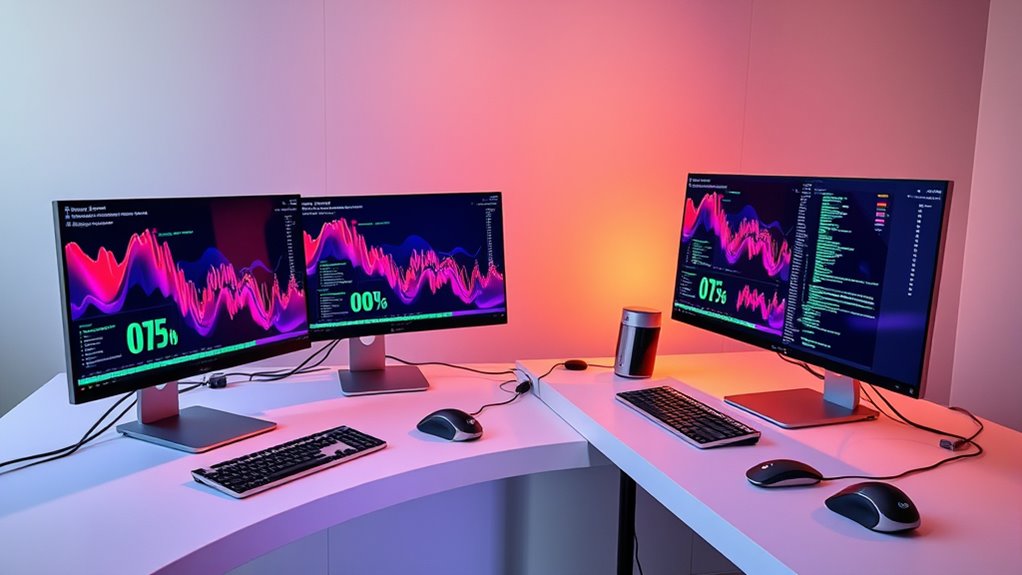If you’re looking for the best Mac Studio setups for machine learning in 2025, I recommend options that are compact yet powerful, like models with the latest M4 or M4 Pro chips, 24-32GB of RAM, and ample SSD storage. Prioritize systems with Thunderbolt 4/5 ports for external GPU support and high-speed data transfer. These configurations offer future-proofing and efficiency, making them ideal for demanding ML tasks. Keep exploring to discover the top choices that match your needs.
Key Takeaways
- Prioritize Mac Studio models with M4 Pro chips, 32GB+ RAM, and 8TB SSD for high-performance ML workflows.
- Opt for setups with Thunderbolt 5 ports and external high-speed SSDs to maximize data transfer and storage.
- Include external GPU enclosures compatible with Thunderbolt 4/5 for additional processing power.
- Choose configurations with future-proofed software support, ample memory, and scalable external storage.
- Balance cost and performance by selecting high-end internal specs while leveraging external upgrades for flexibility.
Apple Mac mini Desktop Computer with M4 Chip, 16GB RAM, 256GB SSD
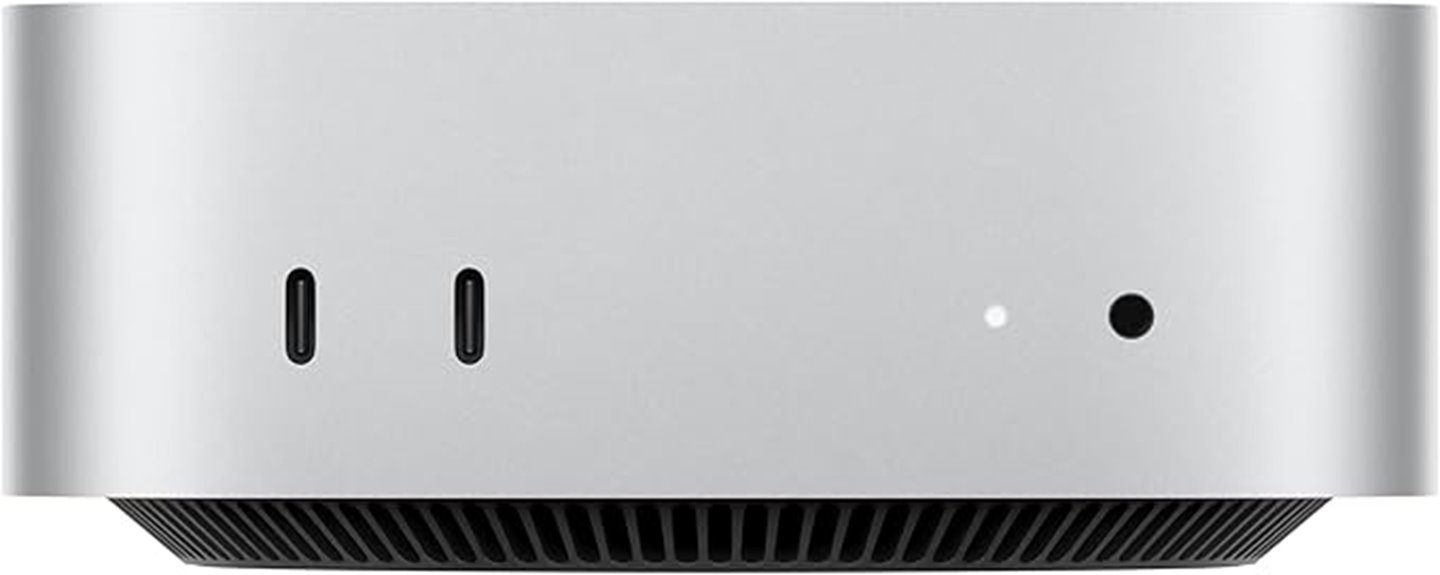
If you’re looking for a compact yet powerful machine for machine learning in 2025, the Apple Mac mini with the M4 chip is an excellent choice. Its five-by-five-inch size makes it easy to fit next to your monitor or in tight spaces, yet it delivers impressive performance. Powered by a 10-core CPU, a 10-core GPU, and 16GB of unified memory, it handles multitasking, video editing, and ML workloads smoothly. The 256GB SSD offers fast storage, and support for multiple high-resolution displays enhances productivity. Plus, its quiet operation and sleek design make it a stylish, space-efficient addition to any workspace.
Best For: professionals and creatives seeking a compact, powerful desktop for multitasking, video editing, and machine learning workloads in a space-efficient design.
Pros:
- Compact size with sleek, attractive design fits easily next to monitors or in small spaces
- Powerful M4 chip with 10-core CPU and GPU delivers excellent performance for demanding tasks
- Quiet operation and efficient cooling make it suitable for noise-sensitive environments
Cons:
- Limited internal storage options; internal SSD is non-upgradable after purchase
- RAM and storage upgrades are not possible post-configuration, which may impact future needs
- HDMI cable issues reported by some users; requires high-quality cables for optimal performance
Apple 2024 Mac mini Desktop Computer with M4 Chip
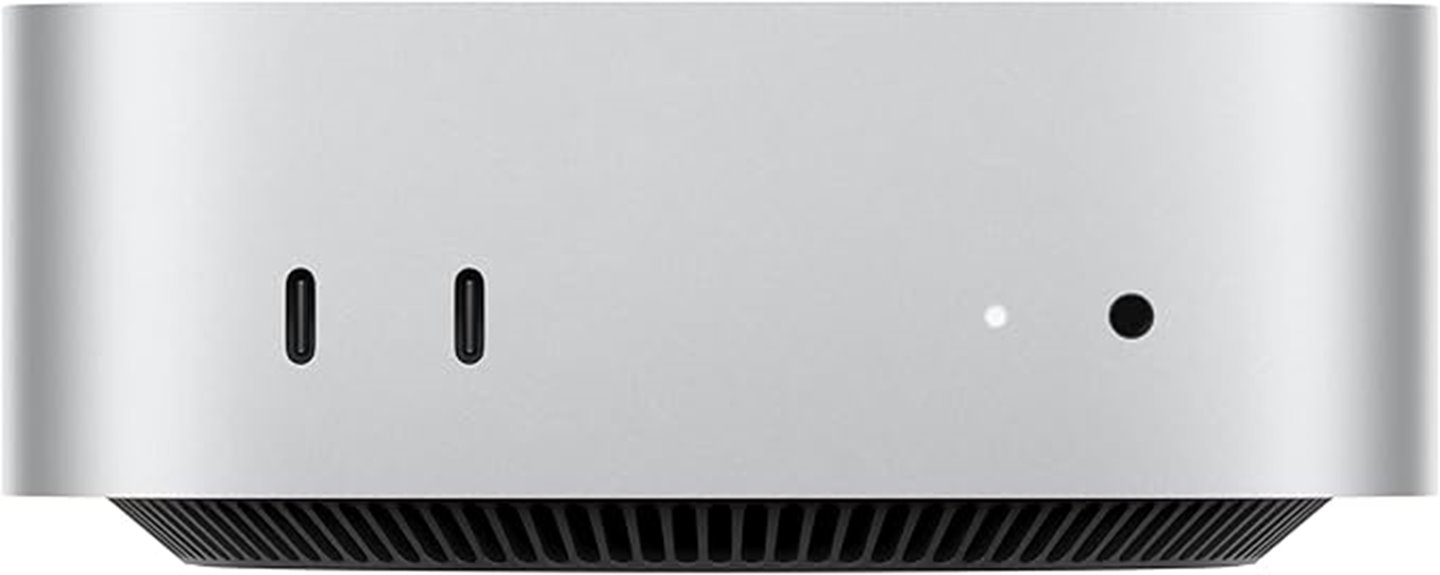
The Apple 2024 Mac mini with M4 chip is an ideal choice for those seeking a compact yet powerful machine learning setup, especially in space-constrained environments. Its tiny footprint (5×5 inches, 2 inches thick) packs impressive performance with a 10-core CPU, 10-core GPU, and a 16-core Neural Engine. The high-quality build and silent operation make it perfect for quiet, efficient workflows. With 16GB of unified memory and fast SSD options, it handles data processing smoothly. Support for multiple high-resolution displays, Thunderbolt 4, and seamless Apple ecosystem integration further enhance its versatility, making it a reliable, future-proof desktop for machine learning enthusiasts.
Best For: users seeking a compact, powerful, and versatile desktop ideal for machine learning, multimedia editing, and space-efficient setups.
Pros:
- Compact size and lightweight design fit easily into any workspace or on-the-go environment.
- Powerful M4 chip with 10-core CPU and GPU ensures fast processing and graphics performance.
- Seamless integration with the Apple ecosystem enhances productivity and user experience.
Cons:
- Limited internal expandability and non-upgradable RAM/storage options may restrict future upgrades.
- Higher-performance configurations can be costly relative to other small desktop options.
- Some users may have privacy or obsolescence concerns due to fixed hardware specifications.
Apple Mac mini Desktop Computer with M4 Chip (2024)
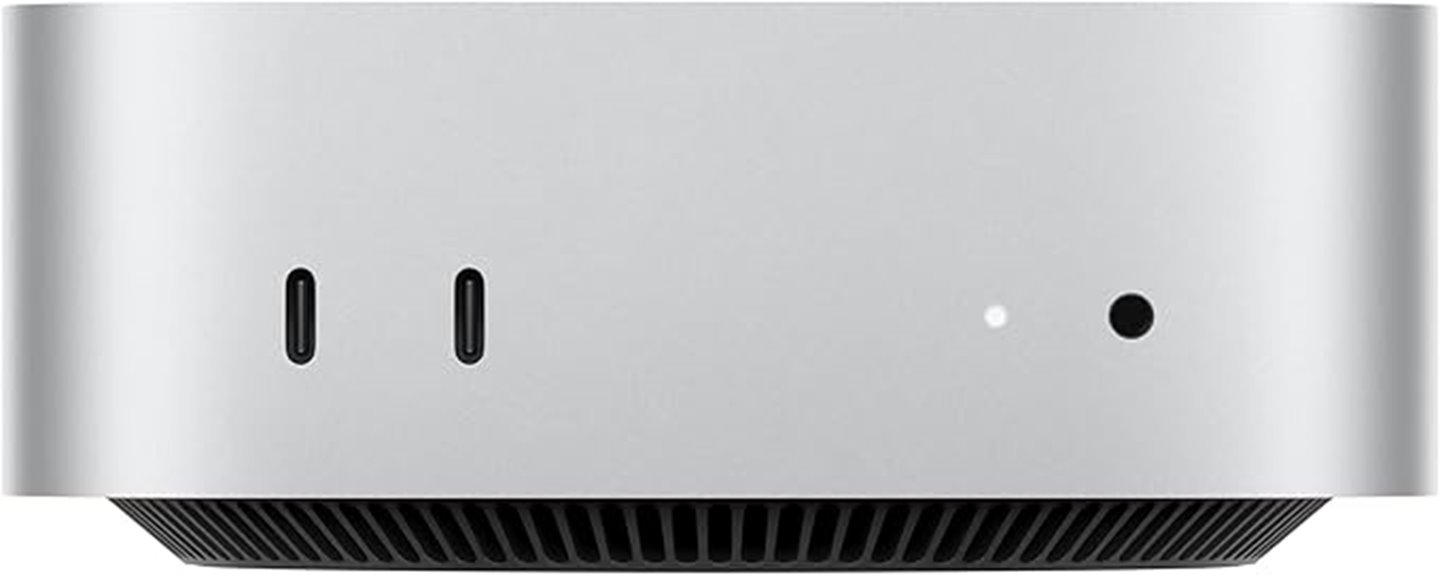
For those seeking a compact yet powerful machine learning setup, the Apple Mac mini with M4 chip (2024) is an excellent choice. Its small 5×5-inch design fits easily next to monitors and offers impressive performance with a 10-core CPU, 10-core GPU, and 16-core Neural Engine. With 24GB of unified memory, configurable to 32GB, and storage options up to 2TB, it handles demanding tasks smoothly. It supports multiple high-resolution displays and features fast connectivity via Thunderbolt 4, HDMI, and Ethernet. Quiet and efficient, it’s perfect for space-conscious users who need reliable, future-proof performance for machine learning, automation, and creative workflows.
Best For: users seeking a compact, high-performance desktop ideal for machine learning, creative workflows, and space-efficient setups.
Pros:
- Powerful M4 chip with 10-core CPU and GPU for demanding tasks
- Compact 5×5-inch design fits easily in any workspace
- Supports multiple high-resolution displays and fast connectivity options
Cons:
- Non-upgradable RAM and storage limits future expandability
- Higher cost compared to traditional mini PCs with similar specs
- Limited port options for extensive peripheral connections
Apple Mac mini Desktop Computer with M4 Pro chip and 24GB Memory
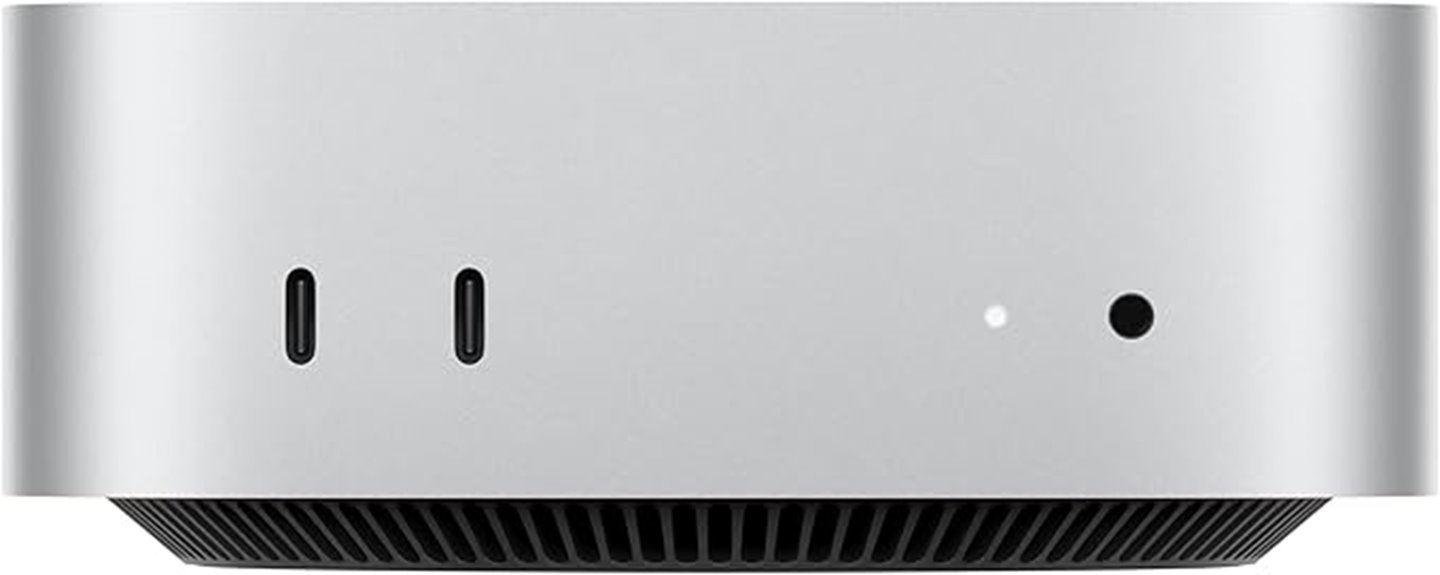
With its powerful M4 Pro chip and 24GB of unified memory, the Apple Mac mini Desktop Computer delivers exceptional performance in a compact form factor, making it an ideal choice for machine learning enthusiasts who need a space-efficient yet capable workstation. Its 12-core CPU, 16-core GPU, and hardware-accelerated media engines handle demanding tasks like data processing, model training, and visualization effortlessly. The device supports up to three 8K displays, fast Thunderbolt 5 ports, and reliable wired and wireless connectivity. Despite its small size, it’s a robust tool for AI development, offering seamless integration within the Apple ecosystem and room for future upgrades.
Best For: machine learning enthusiasts, AI developers, and professionals needing a compact yet powerful workstation for demanding data processing and visualization tasks.
Pros:
- Compact five-by-five-inch design ideal for space-constrained environments
- Exceptional performance with M4 Pro chip, 12-core CPU, and 24GB unified memory
- Supports up to three 8K displays and fast Thunderbolt 5 ports for high-resolution and high-speed connectivity
Cons:
- Non-upgradable RAM and storage, limiting future hardware flexibility
- External accessories like SSDs and high-quality cables are often necessary for optimal performance
- Price point may be high for budget-conscious users seeking expandable hardware options
Factors to Consider When Choosing a Mac Studio for Machine Learning
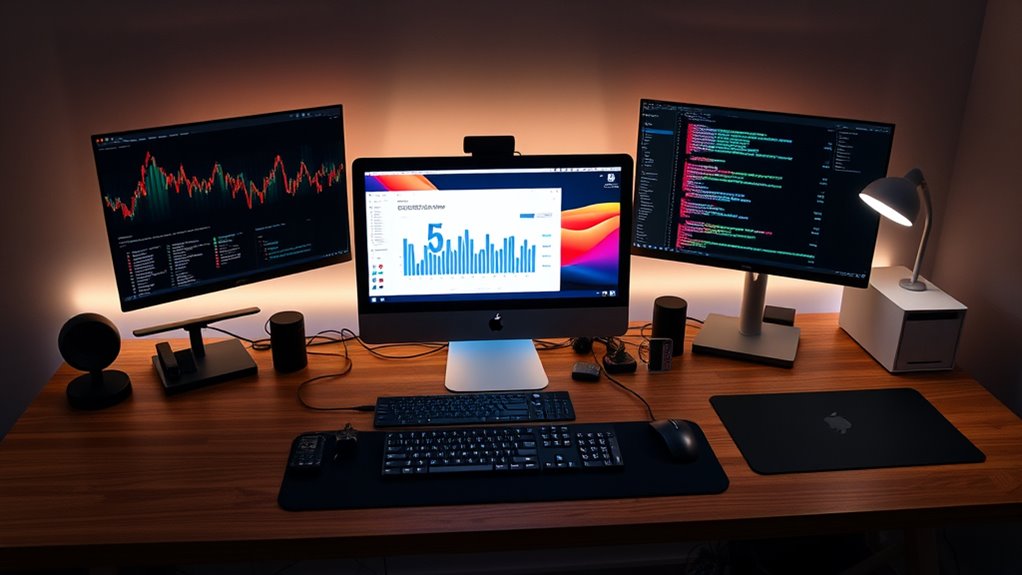
When selecting a Mac Studio for machine learning, I focus on processing power, GPU capabilities, and memory capacity to handle intensive tasks efficiently. Storage options and software compatibility also matter, ensuring I can work smoothly and expand as needed. Considering these factors helps me choose a setup that’s both powerful and future-proof.
Processing Power Needs
Choosing the right Mac Studio for machine learning hinges on understanding its processing power. Machine learning tasks demand high CPU and GPU capabilities, especially for training complex models and processing large datasets. The number of CPU cores affects how quickly data preprocessing and training workflows run, so more cores generally mean faster results. GPU capabilities, including core count and hardware features like ray tracing, directly impact training times and model performance. Adequate RAM is essential for handling large data batches without bottlenecks, ensuring smooth computations. Additionally, supporting multiple high-resolution displays and fast data transfer speeds can boost productivity during development. Ultimately, matching your workload’s intensity with the Mac Studio’s processing power ensures efficient, future-proof machine learning performance.
GPU Capabilities Selection
Selecting the right GPU for your Mac Studio involves evaluating several key factors that directly impact machine learning performance. First, a high core count—24 or more cores—ensures efficient processing of complex computations. Hardware-accelerated ray tracing can boost performance for models that handle 3D data or rendering tasks. A large unified memory buffer, like 48GB or 64GB, improves handling of large datasets and multitasking. Support for high-bandwidth interfaces such as Thunderbolt 4 and HDMI 2.1 guarantees fast data transfer with external devices. Additionally, GPUs with advanced neural engine integration and dedicated hardware decoding/encoding accelerate training and inference processes. Prioritizing these factors helps build a Mac Studio setup that’s powerful, future-proof, and optimized for demanding machine learning workloads.
Memory Capacity Importance
Having sufficient memory capacity is vital for running machine learning workloads efficiently on a Mac Studio. With ample RAM, I can process larger datasets and more complex models simultaneously without slowdowns. Higher memory enables me to multitask effectively, reducing the need to offload data to slower storage during training or inference, which can bottleneck performance. Machine learning workflows often involve loading multiple big files, so enough memory guarantees smooth data handling. Additionally, increasing memory allows me to train models in higher batch sizes, speeding up training and improving accuracy. On the other hand, insufficient memory leads to frequent disk swapping, which drastically hampers performance and extends training times. Consequently, prioritizing memory capacity is vital for a powerful, future-proof Mac Studio setup for machine learning.
Storage Options Flexibility
When setting up a Mac Studio for machine learning, storage options play a key role in guaranteeing smooth workflows and future scalability. The internal SSD configurations range from 512GB to 8TB, so choosing the right capacity upfront is vital, since internal storage isn’t upgradable later. Larger SSDs reduce reliance on external drives, speeding up data access and management. However, they come at a higher initial cost. For additional flexibility, external storage solutions like Thunderbolt 4 or USB-C drives are highly recommended, especially when working with large datasets or multiple projects. Balancing internal capacity with external options allows for efficient data handling, streamlined backups, and adaptable workflows. Ultimately, thoughtful storage planning guarantees your Mac Studio remains effective and future-proof as your machine learning needs evolve.
Software Compatibility Factors
Choosing a Mac Studio for machine learning requires careful attention to software compatibility to guarantee your workflows run smoothly. First, verify the system supports the latest macOS version, which is essential for compatibility with popular frameworks like TensorFlow and PyTorch. You also need to confirm that hardware acceleration features, such as Metal support, are compatible with your preferred libraries, ensuring ideal performance. Confirm that GPU drivers and software dependencies are available and well-optimized for the Mac Studio’s hardware configuration. Additionally, check if external tools or SDKs you rely on require specific OS or hardware features. Lastly, consider the availability of software updates and community support, so your setup remains compatible, secure, and future-proof as technology evolves.
Connectivity and Expansion
Connectivity and expansion options are essential considerations when selecting a Mac Studio for machine learning, as they directly impact your ability to handle large datasets and multitask efficiently. The Mac Studio features multiple Thunderbolt 4 ports, enabling high-speed data transfers and extensive peripheral connections, which are crucial for managing large datasets and complex workflows. It supports several external displays, making multi-monitor setups easier for data visualization and model monitoring. USB-C and USB-A ports add versatility, allowing connection to external GPUs, storage devices, and specialized hardware. Built-in Ethernet, often configurable to 10Gb, ensures fast data access and transfer speeds. Its expansion options also support additional hardware accelerators, helping optimize machine learning performance and future-proofing your setup.
Budget and Cost
Budget and cost are critical factors to contemplate when selecting a Mac Studio for machine learning, as they directly influence the hardware options available. Prices typically range from $2,000 to over $4,000, depending on configuration. Upgrading RAM and GPU greatly hikes the overall price, so balancing performance needs with budget limits is essential. External accessories like additional storage or specialized peripherals can also add to the total cost. It’s important to evaluate your expected workload and determine the return on investment, ensuring the hardware you choose delivers the performance gains needed without overspending. Being mindful of these costs helps you make informed decisions, ensuring your Mac Studio setup aligns with both your machine learning requirements and financial constraints.
Frequently Asked Questions
How Does the M4 Chip Compare to Previous Mac Models for ML Tasks?
The M4 chip outperforms previous Mac models for machine learning tasks thanks to its advanced architecture and increased neural engine cores. I’ve noticed faster training times and smoother performance, especially with large datasets. It’s more efficient, consumes less power, and handles ML workloads seamlessly. Compared to older chips, the M4 really elevates the ML experience, making it a great upgrade for anyone serious about AI and data processing.
What Additional Peripherals Enhance Mac Studio Performance for Machine Learning?
Adding high-speed external SSDs considerably boosts my Mac Studio’s performance for machine learning tasks. I also use a professional-grade GPU via Thunderbolt, which accelerates computations. A high-quality monitor helps me visualize data more clearly, while a reliable UPS safeguards against power interruptions. These peripherals, combined with the Mac Studio’s internal power, streamline my workflow and ensure faster, more efficient ML training sessions.
Can the Mac Mini’s Integrated GPU Handle Large ML Datasets Efficiently?
You might be surprised, but the Mac Mini’s integrated GPU isn’t ideal for handling large ML datasets efficiently. I’ve found it struggles with heavy workloads, causing delays and frustration. For serious machine learning tasks, I recommend a setup with a dedicated GPU, like those in Mac Studios, to guarantee faster processing and smoother workflows. Relying solely on the integrated GPU just won’t cut it for demanding datasets.
How Future-Proof Are the Current Mac Studio Configurations for Upcoming ML Advancements?
I believe the current Mac Studio configurations are quite future-proof for upcoming ML advancements. With Apple’s continual hardware improvements and software updates, these setups can handle more complex models and larger datasets over time. I’d recommend pairing the Mac Studio with ample RAM and fast storage to maximize longevity. Staying updated with the latest software guarantees you’ll be ready for new ML tools and techniques as they emerge.
What Software Optimizations Are Available for Mac Studio to Improve ML Workflows?
I focus on optimizing my Mac Studio for machine learning by leveraging software tools like TensorFlow and PyTorch, which now support Apple Silicon. I guarantee I’m using the latest macOS updates for performance improvements and compatibility. Additionally, I tweak system settings, enable GPU acceleration where possible, and utilize virtualization for training environments. These steps help me maximize efficiency and keep my workflows smooth and future-ready.
Conclusion
As you explore these setups, think of your Mac Studio as a sturdy vessel ready to navigate the vast seas of machine learning. Each configuration offers a unique compass—power, efficiency, and future readiness—to guide your journey. While no ship is without its gentle sways, choosing the right one will help you sail smoothly toward your goals. Trust your instincts, and let your vision set the course for a successful voyage ahead.
